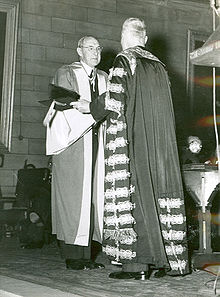Norman McAlister Gregg
Sir Norman McAlister Gregg (born March 7, 1892 in Burwood, Sydney , † July 27, 1966 ) was an Australian ophthalmologist who was the first to discover the connection between rubella infection during pregnancy and congenital malformations, including of the eyes, in newborns. This rubella embryo fetopathy was also named Gregg syndrome after him .
Life
Gregg was born in a suburb of Sydney as the youngest of six children of auctioneer James Gregg and his wife Mary (née Miller). After completing his education in high schools in Homebush and Sydney, he studied at the University of Sydney. Here Gregg was not only academically successful, but also demonstrated his athletic skills on the cricket team of New South Wales and the national tennis team. Only the outbreak of World War I prevented his participation in the Davis Cup for Australia.
After completing his first-class medical degree, Gregg went to England in 1915 and joined the Royal Army Medical Corps as a lieutenant . Until 1918 he served with the 7th Battalion of the East Yorkshire Regiment on the Western Front. He was then assigned to the 52nd field ambulance until March 1919. Back home, he worked as an assistant doctor at the Royal Prince Alfred Hospital before returning to England to train as an ophthalmologist. He received his diploma in ophthalmology and surgery in 1922 and began practicing in Sydney in 1923. In the same year he was appointed eye surgeon at the Royal Prince Alfred Hospital . From 1925 on he held the same position at the Royal Alexandra Hospital for Children . In 1952 and 1950, respectively, he also became an independent doctor at these two houses. In 1923 he married Haidée Magaret. With her he had two daughters who became physiotherapists.
In addition to his medical practice, Gregg was President of the Ophthalmic Society of New South Wales in the early 1930s, and from 1944 to 1945 of the Ophthalmic Society of Australia. From 1940-51 he lectured on diseases of the eyes at the University of Sydney. From 1946 as Vice-President and from 1951 to 1966 as President of the Hospital Board of the Royal Prince Alfred Hospital , he oversaw significant improvements to the welfare of the children, such as the lifting of restricted visiting hours and a loosening of the overall atmosphere in favor of a friendly, family atmosphere. Gregg was a co-founder of the Ophtalmic Research Institute of Australia and Vice President of the Children's Medical Research Foundation .
Act
In 1941 Gregg noticed that he was presented with two to three times as many babies with congenital cataracts than would have been expected based on the probability of inheritance. When he overheard a conversation between two of his patients' mothers in his anteroom who were talking about their rubella disease during pregnancy, he pricked up his ears. His research found that of 78 babies born with congenital cataracts in Sydney in the first few months of 1941, 68 had been exposed to rubella infection in the womb. He published the results of these investigations in October 1941 under the title Congenital Cataract following German Measles in the Mother in the organ of the Australian Ophthalmological Society. After the observations were published in the lay press, Gregg received calls from two mothers telling him that they had also had rubella during pregnancy. Her children are deaf, but otherwise have none of the malformations reported by Gregg. This led to another publication entitled Further Observations on Congenital Defects in Infants following Maternal Rubella . Internationally, his findings were initially still in doubt. It was only when Oliver Lancaster , formerly a doctor, later statistician and epidemiologist , analyzed Gregg's data and demonstrated the connection between the virus and the congenital malformation syndrome as highly significant , that they were recognized beyond Australia's borders.
Individual evidence
- ^ A b c d e f Paul AL Lancaster: Norman McAlister Gregg . In: Douglas Pike (Ed.): Australian Dictionary of Biography . Melbourne University Press, Carlton (Victoria) 1966–2012 (English).
- ↑ a b p Manteuil-Brutlag: Sir Norman Gregg, interview with Dr. MA Burgess (English, pdf; 8 kB) ( Memento of the original from September 17, 2006 in the Internet Archive ) Info: The archive link was inserted automatically and has not yet been checked. Please check the original and archive link according to the instructions and then remove this notice.
| personal data | |
|---|---|
| SURNAME | Gregg, Norman McAlister |
| ALTERNATIVE NAMES | Gregg, Norman; Gregg, Norman McAllister |
| BRIEF DESCRIPTION | Australian ophthalmologist, first to describe rubella embryo fetopathy |
| DATE OF BIRTH | March 7, 1892 |
| PLACE OF BIRTH | Burwood, Sydney |
| DATE OF DEATH | July 27, 1966 |
